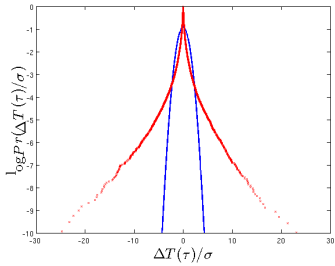Intermittency quantification
The intermittency can be quantified using the definition of the flatness. To this end, we use a high pass filtered signal
 defined as :
defined as :

We can say that the variable
 is intermittent at small scales if the flatness grows without bound with the filter frequency
is intermittent at small scales if the flatness grows without bound with the filter frequency
 .
.

The flatness is useful measure of intermittency for signals having a bursty aspect. Instead of flatness it is possible to use other nondimensional ratios, such as the moment of order 6 divided by the cube of the second moment order.





